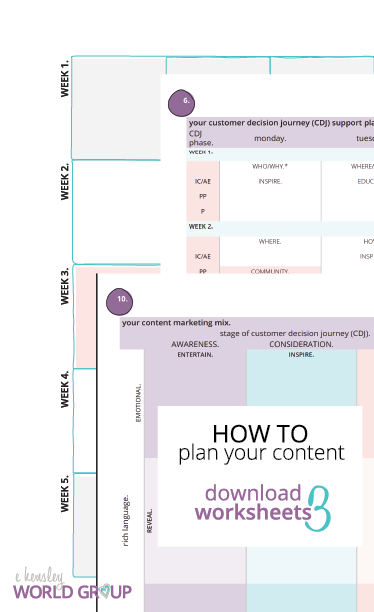how to share a balanced story on social media.
figure 1. On the left, stylized three-phase marketing and sales funnel with groupings of three abstract people moving through until bottom grouping appears with a heart in a cloud bubble. On the right, an abstract editorial calendar for May with a paintbrush, heart, and three stars one of which has a dollar sign in it. for May.
Effective storytelling requires balance. Too much introspection and we may not connect with a wider community. Too much sales content and we can alienate those we have connected with.
Balance means we need to think about why we’re sharing everything. And that means you need to know what goal the information you’re sharing supports.
TELL WHAT APPEARS TO BE ALL OF YOUR STORY (PLAN YOUR ARC).
For your story to appear organic and natural, first identify:
what you want to be known for (the content you will create),
how you’ll establish credibility (showing behind the scenes details or people you work with or highlighting people you have helped and the results you’ve achieved), and
what you want people to do (what actions do they need to take to make your vision a reality).
figure 2. pink arrow pointing left to right from an abstract person holding three stars, one gray, one purple, and one pink to a wand and heart over a magician’s hat with three stars swirling to a report with a paintbrush dripping stars.
Once you’ve planned your arc, you can develop an editorial calendar to ensure consistency and achieve balance between current events, your backstory, and your asks. But until you know what you want to say, a calendar won’t help.
CONSISTENTLY RETELL KEY PARTS OF YOUR STORY.
Stories have a beginning, a middle, and an end. They naturally divide themselves into chapters and volumes, with a cadence and rhythm set by major events such as a company being funded, going public, having a new executive chef take over, eliminating GMO ingredients from the menu, and so on.
Because you can’t assume where someone starts with your story, you need to consistently retell past chapters of your story--abridged versions of your story that support your why and those that establish you as an expert, a trusted resource, and an authority on what you do.
figure 3. five-week schedule for planning content marketing. Focus is on details about what you do, how you do it, and for whom. Each of the five weeks has a different three-day a week posting schedule with type of content (What, How, and Who) appears once during a week as well as on one Monday, Tuesday, Wednesday, Thursday, and Friday. First week suggests What on Monday, nothing on Tuesday, How on Wednesday, nothing on Thursday, and Who on Friday. This pattern repeats itself each week with suggested type of content moving a day earlier in the week. For example, second week shifts suggestions of How, Who, and What to Tuesday, Thursday, and Friday, respectively.
You have to think like a movie director, proactively including flashbacks when the audience might not understand your motivation.
SET GOALS FOR THE CONTENT YOU'LL SHARE.
We all have selfish reasons for telling our stories and sharing information. Many of those reasons consciously or unconsciously lead to a sustainable living, from protecting the planet to earning a living wage.
So for now, let’s all assume we want people to take action after reading our stories. (Action doesn’t have to be a monetary transaction or tangible, it could be we want people to like us a little better after they hear our story.)
For a business or personal brand, there are four primary goals:
to inspire.
Get your audience to dream bigger. If you have a revolutionary product or service, aspirational content showing potential uses and benefits can highlight a need people didn’t know they had.
to educate.
Discuss what’s unique about what you and why you do what you. Your audience learns how you envision them using your product.
to reveal.
Include behind the scenes details that spark the imagination of your community and identify the people who make the product/deliver the experience they love.
to involve.
Connect with members of your community by showing what they are doing; get them excited to support your why; and make them proud to say they’re a member.
figure 4. five-week schedule for supporting content goals: inspiration, education, involvement, and promotion (asks). Proposed mix of content goals aims for natural balance of conversation and soft-sell promotion with at least two days between asks up to six days. Content for each goal appears at least once during a week as well as least once on a Monday, Tuesday, Wednesday, Thursday, or Friday. First week starts with content meant to inspire on Monday, to educate on Tuesday, to involve on Wednesday, with inspirational content repeated once again on Thursday. Promotional content (or an ask) can be planned for Friday, Sunday, or the following Monday. Test to determine the best mix for an audience. Second week begins inspirational content on Tuesday, educational content on Wednesday, content meant to involve on Thursday, with a promotion or ask on Friday. Third week starts with promotional content on either Monday or Tuesday, followed by inspiration on Wednesday, educational content on Thursday, and content meant to spark involvement on Friday.
PLAN CONTENT TO COVER YOUR CUSTOMER DECISION JOURNEY (CDJ).
Some parts of our story are easier to tell than others, for example, education versus inspiration. And there's the temptation when time is short or resources are tight to write what's comfortable. (Well-written, engaging case studies take more planning than a general how to.)
But remember, content is about them—not you. Focus on how they consuming your product or service. Have them picture their life today. Then show them what their lives would be like with you in it.
IDENTIFY GAPS IN YOUR CONTENT.
figure 5. content with different goals supports different stages of a customer’s decision journey (CDJ). 3x3 grid arranges goal-focused content based amount of rich language (amount of emotional appeals) from less to more across the CDJ stages of Awareness to Consideration to Purchase. Three grids for raising awareness starting with content having fewer emotional appeals rising to more are Educate, Reveal, Entertain. Three grids for increasing purchases from less to more emotional appeals are Convince, Involve, Engage.
Do you know where your story has gaps? Once you know the holes in your story, you can start brainstorming your future content and planning its creation, review, and promotion.
Download your content marketing matrix worksheet (PDF) to identify any gaps. Then take the time to regularly audit your content marketing efforts. You’ll want to update this matrix at least once a quarter so that you can keep your content current and fresh for each stage of your customer decision journey.
PDF with 3 worksheets for planning your content. Five-week schedule with partial left-hand corners of two of the included worksheets. Corner of page 6, Your Customer Decision Journey (CDJ) Support Plan, five-week plan that overlays who, what, where, why, how content type with inspire, educate, involve, and ask goal-based content. Corner of page 10, Your Content Marketing Mix audit worksheet (a 3x3 grid). got your content on lock? pin for later.
Like what you've just read? Subscribe to receive Letters to Entrepreneurs in your inbox and get more insights such as these!






